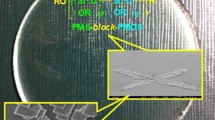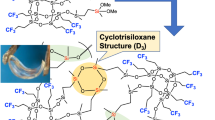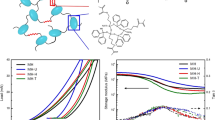Abstract
Polysiloxane derivative (MPS), obtained from the reaction of polymeric tributylstannyl ester of silicic acid (PTBS) and (3-methacryloyloxypropyl)dimethylchlorosilane (1a), was shown to be a useful inorganic component for the preparation of organic-inorganic hybrid resin as a nanocomposite. Copolymerization of MPS containing methacryloyloxypropyl groups with the common monomer such as styrene, acrylonitrile, or methyl methacrylate proceeded readily at room temperature under UV irradiation to give the corresponding resins (HR). The resins obtained from MPS and methyl methacrylate showed a good transparency and resistance in scratch test, but a poor flexibility. The gels consisted of analogous structure to HR were obtained from PTBS, 1a, and the monomer by one-pot procedure, in which substitution and polymerization proceeded simultaneously.
Similar content being viewed by others
References
(a) B.M. Novak, Adv. Mater. 5, 422 (1993); (b) C. Sanchez and F. Ribot, New J. Chem. 18, 1007 (1994); (c) A. Sellinger and R.M. Laine, Macromolecules 29, 2327 (1996); (d) C. Zhang and R.M. Laine, Chem. Mater. 8, 1592 (1996); (e) W. Zhou, J.H. Dong, K.Y. Qiu, and Y. Wet, J. Polym. Sci. Polym. Chem. Ed. 36, 1607 (1998); (f) R. Tamaki, K. Naka, andY. Chujo, Polym. J. 30, 60 (1998).
(a) H. Inoue and S. Kohama, J. Polym. Sci. Polym Chem. Ed. 19, 759 (1981); (b) G. Philipp and H. Schmidt, J. Non-Cryst. Solids 63, 283 (1984); (c) Y. Abe, T. Namiki, K. Tuchida, and Y. Nagao, J. Non-Cryst. Solids 47, 147 & 148 (1992); (d) B.M. Novak, M.W. Ellsworth, and C. Verrier, Polym. Mater. Sci. & Eng. 70, 266 (1993).
L.L. Hench and J.K. West, Chem. Rev. 90, 33 (1990).
T. Sugizaki, M. Oikawa, O. Moriya, and T. Kageyama, J. Polym. Sci. Polym. Chem. Ed. 37, 2363 (1999).
T. Sugizaki, Y. Sasaki, O. Moriya, Y. Nakamura, T. Endo, and T. Kageyama, J. Polym. Sci. Polym. Chem. Ed. accepted.
E. Lippmaa, M. M¨agi, A. Samoson, G. Engelhardt, and A.G. Grimmer, J. Am. Chem. Soc. 102, 4889 (1980).
D. Derouet, S. Forgeard, J.-C. Brosse, J. Emery, and J.-Y. Buzare, J. Polym. Sci. Polym. Chem. Ed. 36, 437 (1998).
Standard Method of Japan, JIS K5400.
A.G. Davies, Oragnotin Chemistry (VCH, Weinheim, 1997), p. 194.
Author information
Authors and Affiliations
Rights and permissions
About this article
Cite this article
Moriya, O., Sugizaki, T. Synthesis of Polysiloxane Having Methacryloyloxy Group from Tributylstannyl Ester of Silicic Acid and Silane Coupling Agent. Journal of Sol-Gel Science and Technology 19, 489–493 (2000). https://doi.org/10.1023/A:1008768001637
Issue Date:
DOI: https://doi.org/10.1023/A:1008768001637




